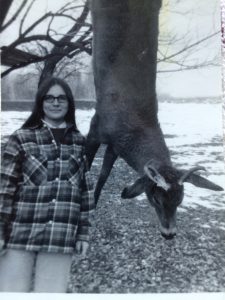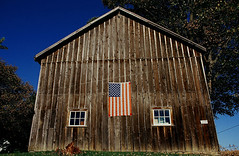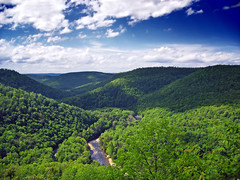Deer Memories

My eyes shift quickly to the left side of the road as I round the sharp curve, drawn to a boy dressed in hot orange, standing in stark contrast to the dull December browns of the Pennsylvania fields. Three more men flash by my window at sixty-yard intervals, each in orange garb and with rifles slung over their shoulders, waiting to move into the woods. “Oh yeah, it’s the first day of deer season and school’s closed,” I remind myself, and feel a surge of envy as the last man disappears from my rear-view mirror.
Deer hunting! Thirty-some years after hanging up my rifle, that first-day urge still tugs at me even as I head to the mall. My mind wanders into the fields and forests of my childhood. Well actually, perhaps because I’ve skipped breakfast, my first thoughts are of our old farmhouse kitchen table with plates piled high with fried deer steak and hot pancakes, pitcher of homemade brown sugar syrup ready for pouring. “Wish I had some right now,” I think, remembering a time long ago when our farm neighbors from “The Hill” gathered together after the season to share this simple fare, swapping tall tales of the big bucks that got away, playing pitch, and just plain visiting.
My brother hated hunting, but I embraced it, impatiently waiting to turn twelve, and the thrill of my first hunting license wasn’t matched until four years later at the DMV. My dad welcomed my interest in his passion. In the weeks before the season opened, we’d cruise the back roads surrounding our farm, beaming a spotlight into the far corners of the fields, assessing the number of deer and the promise of trophy racks. And then, a couple of days before the Big Day, we’d sight our rifles in by leaning against a porch beam and shooting across the lawn into the black-ringed paper target.
My first gun, a 38-40 Winchester was Gene Autry and John Wayne movie-cool, with a Rifleman-like lever action. For the first three or four years of hunting, no matter where I stood – open field, full woods, or thick brush, the deer came to me, somehow knowing that I couldn’t hit the broad side of a barn with that old 38-40. My father finally bought me a 30-30 Savage, with bolt action. I could hit the barn, but I didn’t feel nearly as cool!
A few more miles down the road, I spy another hunter; a young girl, standing with rifle butt sitting on the toe of her boot, slightly bent over and drawn into herself. “Yeah, I remember standing like that for hours! Freezing, but not wanting to admit it or give up for the day.” After a few years of hunting with a gang of relatives and neighbors, my dad and I settled into a smaller gang – just the two of us. Outside before daylight, we’d take turns during the day standing in our special deer runs while the other walked through the woods to stir up the deer. Alternating between cold-to-the-bone standing and sweaty-hot-in-the-cold walking, we’d cover every inch of our hundred-fifty acres and much of the neighbors’, hope still alive, only driven homeward by darkness.
“I’ve got to get the gun-cleaning fluid out someday soon and take a whiff of it,” I think, weaving into the left lane of traffic. “I can’t quite bring back the smell of Hoppe’s, but I know it smelled really good.” Everything smelled, tasted, and felt good after a long day in the cold – often in snow, sleet, or rain, lugging a rifle up hill and down, fighting through briar patches that grabbed and held on, and climbing over slippery stone walls. Hot dogs frying in butter smelled better than steak on a grill. Baked beans from a can and warmed up on the stove called out as strongly as any gourmet dish Julia Child could cook up. Coconut washboard cookies rivaled fresh crème Brule as the perfect dessert. Feast complete, my dad would light his pipe, while I snuggled under an old quilt on the couch, fading in and out of an out-of-the-cold, body-so-tired sleep as Walter Cronkite read the news.
I remember clearly the day when my 30-30 finally found its mark…the thrill of a snapping twig, slipping the safe off and raising the rifle, waiting, straining to see through snowflakes, aiming, heart racing, adrenaline shutting out the cold, waiting a few more agonizing seconds to make sure, squeezing the trigger, barely feeling the recoil, ejecting the bullet, aiming again, squeezing again, watching helplessly as the deer disappeared, running awkwardly after it in heavy boots, struggling to keep upright on the frozen tufts of dead grass… My father, hampered by his color blindness, looked to me to follow the trail of bright red drops on the brown forest floor. Finally sighting the downed deer, he strode up to it, proud of his daughter and pleased with our day. Pulling out his knife to claim it as ours, he warmed his hands in the rising steam as he worked.
As I slam the Buick door and head for Macys, my attention starts to shift to the Christmas presents waiting inside. One last first-day thought crosses my mind – a reminder to myself to call my father, a master hunter still at it in his eighty-third year. I’ll say, “Thanks, dad, we were great hunters together, weren’t we?”
I eventually lost interest in hunting, growing too soft to stand in freezing weather, swayed by a husband who only bow hunted, busy with job and family, and reaching a point, as my youngest son put it, where I didn’t want to kill those forest creatures! For several years though, hunting created a strong bond between my father and me. My love for the land and its wildlife also grew from those hours spent traipsing through the fields and forests of northeastern Pennsylvania…another reason that home always beckons.








